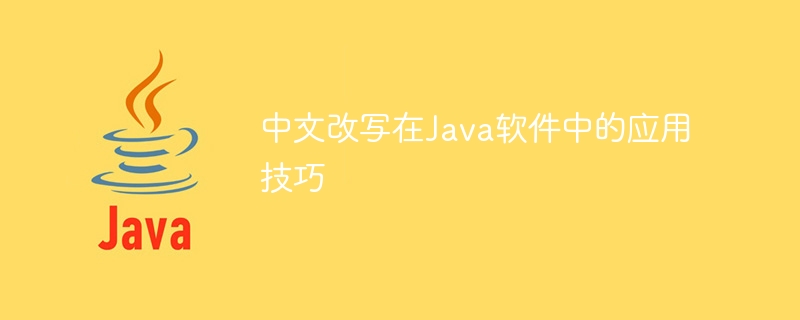Practical tips in Java software

Application skills of Chinese rewriting in Java software
Abstract: Chinese rewriting refers to the process of converting a Chinese text into another Chinese expression with similar meaning. In Java software development, Chinese rewriting can improve user experience and search engine optimization. This article will introduce the application skills of Chinese rewriting and provide specific code examples.
- Selection of NLP library
When rewriting Chinese in Java, we can use the natural language processing (NLP) library to help us with sentence segmentation and part-of-speech tagging , syntax analysis and other operations. Commonly used NLP libraries include HanLP, Stanford NLP and NLPIR. The following is a sample code using HanLP for word segmentation:
import com.hankcs.hanlp.HanLP;
import com.hankcs.hanlp.seg.common.Term;
public class NLPExample {
public static void main(String[] args) {
String sentence = "我家的狗很可爱。";
List<Term> termList = HanLP.segment(sentence);
for (Term term : termList) {
System.out.println(term.word);
}
}
}- Synonym replacement
A common method for Chinese rewriting is to use synonym replacement. By replacing certain words in the text with words that have a similar meaning to them, you can change the way the sentence is expressed to make it more relevant to the user's needs. The following is a sample code that uses HanLP to implement synonym replacement:
import com.hankcs.hanlp.HanLP;
import com.hankcs.hanlp.suggest.Suggester;
public class SynonymReplacement {
public static void main(String[] args) {
Suggester suggester = new Suggester();
suggester.addSentence("苹果是一种水果。");
suggester.addSentence("苹果手机很受欢迎。");
String input = "我想买个手机。";
List<String> suggestList = suggester.suggest(input, 1);
if (suggestList.size() > 0) {
String suggestion = suggestList.get(0);
String output = input.replace("手机", suggestion);
System.out.println(output);
}
}
}- Antonym replacement
In addition to using synonym replacement, we can also use antonym replacement for Chinese rewriting. By replacing certain words in the text with words that have the opposite meaning, you can change the meaning of a sentence. The following is a sample code that uses HanLP to implement antonym replacement:
import com.hankcs.hanlp.HanLP;
import com.hankcs.hanlp.dictionary.stopword.CoreStopWordDictionary;
import com.hankcs.hanlp.seg.common.Term;
import com.hankcs.hanlp.tokenizer.StandardTokenizer;
import java.io.IOException;
import java.util.List;
public class AntonymReplacement {
public static void main(String[] args) {
String sentence = "这个电影太好看了。";
List<Term> termList = StandardTokenizer.segment(sentence);
for (Term term : termList) {
if (!CoreStopWordDictionary.contains(term.word)) {
String opposite = getOpposite(term.word);
if (opposite != null) {
sentence = sentence.replace(term.word, opposite);
}
}
}
System.out.println(sentence);
}
public static String getOpposite(String word) {
// 返回和word意思相反的词
return null;
}
}Summary: Chinese rewriting is an important part of Java software development and can improve user experience and search engine optimization. By choosing an appropriate NLP library and using techniques such as synonym replacement and antonym replacement, we can rewrite Chinese text. I hope this article is helpful to you, thank you for reading!
The above is the detailed content of Practical tips in Java software. For more information, please follow other related articles on the PHP Chinese website!

Hot AI Tools

Undresser.AI Undress
AI-powered app for creating realistic nude photos

AI Clothes Remover
Online AI tool for removing clothes from photos.

Undress AI Tool
Undress images for free

Clothoff.io
AI clothes remover

AI Hentai Generator
Generate AI Hentai for free.

Hot Article

Hot Tools

Notepad++7.3.1
Easy-to-use and free code editor

SublimeText3 Chinese version
Chinese version, very easy to use

Zend Studio 13.0.1
Powerful PHP integrated development environment

Dreamweaver CS6
Visual web development tools

SublimeText3 Mac version
God-level code editing software (SublimeText3)

Hot Topics
 1378
1378
 52
52
 How does Java's classloading mechanism work, including different classloaders and their delegation models?
Mar 17, 2025 pm 05:35 PM
How does Java's classloading mechanism work, including different classloaders and their delegation models?
Mar 17, 2025 pm 05:35 PM
Java's classloading involves loading, linking, and initializing classes using a hierarchical system with Bootstrap, Extension, and Application classloaders. The parent delegation model ensures core classes are loaded first, affecting custom class loa
 How do I implement multi-level caching in Java applications using libraries like Caffeine or Guava Cache?
Mar 17, 2025 pm 05:44 PM
How do I implement multi-level caching in Java applications using libraries like Caffeine or Guava Cache?
Mar 17, 2025 pm 05:44 PM
The article discusses implementing multi-level caching in Java using Caffeine and Guava Cache to enhance application performance. It covers setup, integration, and performance benefits, along with configuration and eviction policy management best pra
 How can I use JPA (Java Persistence API) for object-relational mapping with advanced features like caching and lazy loading?
Mar 17, 2025 pm 05:43 PM
How can I use JPA (Java Persistence API) for object-relational mapping with advanced features like caching and lazy loading?
Mar 17, 2025 pm 05:43 PM
The article discusses using JPA for object-relational mapping with advanced features like caching and lazy loading. It covers setup, entity mapping, and best practices for optimizing performance while highlighting potential pitfalls.[159 characters]
 How do I use Maven or Gradle for advanced Java project management, build automation, and dependency resolution?
Mar 17, 2025 pm 05:46 PM
How do I use Maven or Gradle for advanced Java project management, build automation, and dependency resolution?
Mar 17, 2025 pm 05:46 PM
The article discusses using Maven and Gradle for Java project management, build automation, and dependency resolution, comparing their approaches and optimization strategies.
 How do I create and use custom Java libraries (JAR files) with proper versioning and dependency management?
Mar 17, 2025 pm 05:45 PM
How do I create and use custom Java libraries (JAR files) with proper versioning and dependency management?
Mar 17, 2025 pm 05:45 PM
The article discusses creating and using custom Java libraries (JAR files) with proper versioning and dependency management, using tools like Maven and Gradle.




